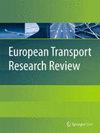Safety evaluation via conflict classification during automated shuttle bus service operations
IF 4.2
3区 工程技术
Q1 TRANSPORTATION
引用次数: 0
Abstract
The widespread adoption of Connected and Automated Vehicles (CAVs) is being propelled, not only in the realm of private vehicles but also within transit systems. This development serves to enhance urban transport activities, rendering transportation more appealing to passengers. The present study aims to identify and examine the safety effects of testing different operational speed shuttle bus services in various future mobility conditions. To investigate impacts of autonomous shuttle bus services and to further examine their operational speed, the microscopic simulation method was performed. Specifically, four sets of simulation scenarios were comprised: a baseline scenario representing the current conditions and three operational speed scenarios (15 km/h, 30 km/h and 45 km/h) for an autonomous shuttle service. Each one of these sets included eleven CAV market penetration rates (MPRs) of CAVs of the general traffic (ranging from 0 to 100% in 10% increments). By analyzing the trajectory data extracted from microsimulation, traffic conflicts were identified and further analyzed by developing Mixed-Effects Multinomial Logit Regression models (ME-MLMs) in order to associate conflict type taking into account network characteristics as well as traffic conditions. Several aspects were determined as statistical significant parameters influencing type of conflict. The analysis yielded several significant findings that provide quantitative measurements and assessments of the effects observed, enabling a better understanding of the safety implications associated with the widespread adoption of automated services.通过自动穿梭巴士运营期间的冲突分类进行安全评估
互联与自动驾驶汽车(CAV)的广泛应用不仅在私家车领域,在公交系统中也得到了推动。这一发展有助于加强城市交通活动,使交通对乘客更具吸引力。本研究旨在确定和研究在各种未来交通条件下测试不同运行速度的穿梭巴士服务对安全的影响。为了研究自主穿梭巴士服务的影响,并进一步考察其运行速度,本研究采用了微观模拟方法。具体来说,模拟场景包括四组:代表当前条件的基线场景和自主穿梭巴士服务的三种运行速度场景(15 公里/小时、30 公里/小时和 45 公里/小时)。每组情景都包括 11 个 CAV 在一般交通中的市场渗透率(MPR)(从 0 到 100%,每 10%递增)。通过分析从微观模拟中提取的轨迹数据,确定了交通冲突,并通过建立混合效应多项式对数回归模型(ME-MLMs)进行进一步分析,以便将冲突类型与网络特征和交通状况联系起来。有几个方面被确定为影响冲突类型的重要统计参数。分析得出了若干重要结论,对所观察到的影响进行了量化测量和评估,使人们能够更好地理解广泛采用自动驾驶服务对安全的影响。
本文章由计算机程序翻译,如有差异,请以英文原文为准。
求助全文
约1分钟内获得全文
求助全文
来源期刊

European Transport Research Review
Engineering-Mechanical Engineering
CiteScore
8.60
自引率
4.70%
发文量
49
审稿时长
13 weeks
期刊介绍:
European Transport Research Review (ETRR) is a peer-reviewed open access journal publishing original high-quality scholarly research and developments in areas related to transportation science, technologies, policy and practice. Established in 2008 by the European Conference of Transport Research Institutes (ECTRI), the Journal provides researchers and practitioners around the world with an authoritative forum for the dissemination and critical discussion of new ideas and methodologies that originate in, or are of special interest to, the European transport research community. The journal is unique in its field, as it covers all modes of transport and addresses both the engineering and the social science perspective, offering a truly multidisciplinary platform for researchers, practitioners, engineers and policymakers. ETRR is aimed at a readership including researchers, practitioners in the design and operation of transportation systems, and policymakers at the international, national, regional and local levels.
 求助内容:
求助内容: 应助结果提醒方式:
应助结果提醒方式:


